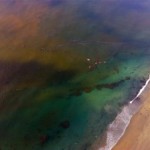
Climbed a mountain and I turned around
I saw my reflection in the snow covered hills
till the landslide brought me down
The largest known arthropod is now followed by the largest known landslide. 60,000 years ago a submarine landslide off the coast of north-west Africa traveled 1,500 kilometers before dumping 225 billion metric tons of sediment. For perspective, 1,500 km is about the distance from Miami to Memphis and 225 billion tons is the weight of about 45 billion male African elephants. One of the authors, Peter Talling, of the article published in Nature stated “This mass was ten times that transported to the ocean every year by all of the Earth’s rivers. The flow was sometimes over 150 km wide, spread across the open sea floor.”






Way to work in only my most favoritist Stevie Nicks song evah!
Any signs of a tsunami hitting the opposite shore?
Any signs of a tsunami hitting the opposite shore?
Any signs of a tsunami hitting the opposite shore?
Any signs of a tsunami hitting the opposite shore?
Any signs of a tsunami hitting the opposite shore?
Any signs of a tsunami hitting the opposite shore?
This may be one of largest deep-sea flows in “recent” history…but it’s always good to appreciate deep time…consider this:
The bed that is the product of this event is 2 m thick in the basin … there are turbidite/debris-flow beds in the geologic record that are routinely >2 m thick (some >10 m thick) all over the place. Many turbidite successions can be a few to several hundreds of meters thick, and are composed of literally hundreds of beds representing events of this magnitude.
So, is this event “special” in the last 200,000 yr? Yes, indeed. Special over geologic time? Hardly.
Brian,
Thanks for the perspective. Perhaps got a bit carried away.
i don’t want to give the impression it’s not a big event…it’s HUGE… which makes me wonder, if something of this magnitude happens, say, once every 100,000 yr…it would certainly have a significant impact on the organisms living on or near the sea floor.
how long do you think it would take for the habitat to return to “normal” after such an event?
Brian,
Great question and with no real answer. A disturbance on the seafloor can take years to fully rebound for given the slow growth rates of deep-sea organisms. A cataclysmic disturbance as such depends on breadth of the impact and how exactly alters the seafloor. It may be quite quick if local habitats not affected can provide larvae/recruits. However, if the sediment regime is greatly altered, i.e. introduction of courser sediments, it may be much slower depending on the length of time for the sediment to return to normal through detrital rain and bioturbation.
Not as humongous as this landslide, but recovery of hydrothermal vent communities wiped out by lava flow took 2 years (full recovery of tubeworms to their lush abundance and size took up to 5 years.) Shank et al. 1998
Craig…thanks for the answer. It’s interesting how places like submarine canyons can be so rich in life and, at the same time, were created by and serve as conduits for these big flows.
Cores I have taken in Monterey Canyon are rich with infauna. At least once every 10 years this area is probably hit with some sort of mass transport of sediment event. Whether these communities are ‘normal’ or represent simply ‘weedy’ species with quick turn around geared toward disturbance I can’t say.
It would be interesting to look at multiple submarine canyons from around the world and evaluate the fauna abundance and diversity within the context of how ‘active’ the canyon is as a sediment conduit. Some have ‘shut down’ since the last glacial max, and some have remained active … has anyone done such a study?
Not in the context your speaking of.
Lets write a grant proposal! You can fund my postdoc
*Will test community ecology theories for meager salary*